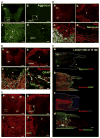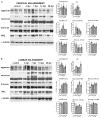Alterations in chondroitin sulfate proteoglycan expression occur both at and far from the site of spinal contusion injury
- PMID: 21952042
- PMCID: PMC3640493
- DOI: 10.1016/j.expneurol.2011.09.008
Alterations in chondroitin sulfate proteoglycan expression occur both at and far from the site of spinal contusion injury
Abstract
Chondroitin sulfate proteoglycans (CSPGs) present an inhibitory barrier to axonal growth and plasticity after trauma to the central nervous system. These extracellular and membrane bound molecules are altered after spinal cord injuries, but the magnitude, time course, and patterns of expression following contusion injury have not been fully described. Western blots and immunohistochemistry were combined to assess the expression of four classically inhibitory CSPGs, aggrecan, neurocan, brevican and NG2, at the lesion site and in distal segments of cervical and thoracic spinal cord at 3, 7, 14 and 28 days following a severe mid-thoracic spinal contusion. Total neurocan and the full-length (250 kDa) isoform were strongly upregulated both at the lesion epicenter and in cervical and lumbar segments. In contrast, aggrecan and brevican were sharply reduced at the injury site and were unchanged in distal segments. Total NG2 protein was unchanged across the injury site, while NG2+ profiles were distributed throughout the lesion site by 14 days post-injury (dpi). Far from the lesion, NG2 expression was increased at lumbar, but not cervical spinal cord levels. To determine if the robust increase in neurocan at the distal spinal cord levels corresponded to regions of increased astrogliosis, neurocan and GFAP immunoreactivity were measured in gray and white matter regions of the spinal enlargements. GFAP antibodies revealed a transient increase in reactive astrocyte staining in cervical and lumbar cord, peaking at 14 dpi. In contrast, neurocan immunoreactivity was specifically elevated in the cervical dorsal columns and in the lumbar ventral horn and remained high through 28 dpi. The long lasting increase of neurocan in gray matter regions at distal levels of the spinal cord may contribute to the restriction of plasticity in the chronic phase after SCI. Thus, therapies targeted at altering this CSPG both at and far from the lesion site may represent a reasonable addition to combined strategies to improve recovery after SCI.
Copyright © 2011 Elsevier Inc. All rights reserved.
Figures






References
-
- Afshari FT, Kwok JC, White L, Fawcett JW. Schwann cell migration is integrin-dependent and inhibited by astrocyte-produced aggrecan. Glia. 2010;58(7):857–869. - PubMed
-
- Ankeny DP, McTigue DM, Jakeman LB. Bone marrow transplants provide tissue protection and directional guidance for axons after contusive spinal cord injury in rats. Exp Neurol. 2004;190 (1):17–31. - PubMed
-
- Bekku Y, Rauch U, Ninomiya Y, Oohashi T. Brevican distinctively assembles extracellular components at the large diameter nodes of Ranvier in the CNS. J Neurochem. 2009;108:1266–1276. - PubMed
Publication types
MeSH terms
Substances
Grants and funding
LinkOut - more resources
Full Text Sources
Other Literature Sources
Medical
Miscellaneous

